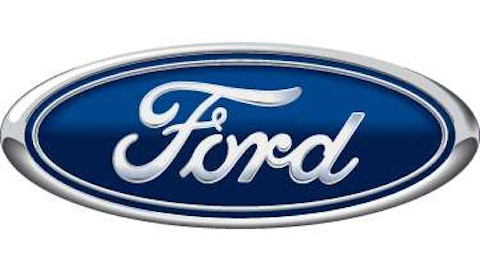
Ford China SUV media event. Photo Credit: Ford Motor Company (NYSE:F).
If you follow the automotive industry you know the elite automakers are all drooling at the potential sales volume expected in China by 2020. General Motors Company (NYSE:GM) is throwing $11 billion toward its investments in China through 2016. Ford Motor Company (NYSE:F) was late to the game in China but is investing nearly $5 billion on new plants there as well as introducing 15 new vehicles by mid-decade. Ford’s sales in China have increased almost 50% through May but the company still trails its crosstown rival General Motors Company (NYSE:GM) by a large margin. This is a gap that Ford Motor Company (NYSE:F) hopes to close as it plans to double its market share over the next few years. One thing is clear, China is a future gold mine for automakers. Here are some details at just how how big China’s surge is and what it means for investors.

China is witnessing a surge in light vehicle demand as a result of its growing middle class. Here are some facts to chew on to better understand the potential in China. Right now mature markets in Europe and here in the U.S. are on pace to sell roughly 12 million and 15.4 million vehicles this year, respectively. Last year China sold just over 19 million vehicles and is projected to sell 27 million vehicles by 2021, according to research from R.L. Polk & Co. Some estimates even have China breaking 30 million in that same time frame. Either of those two estimates is a significant increase compared to estimates that vehicle sales in Europe and the U.S. will reach around 15 million and 17.5 million, respectively, by 2020.
Here’s a tidbit that has executives at Detroit’s Big Three cheering: The Chinese market has over 180 different brands available, yet eight of the 10 top brands are not Chinese. Global automakers are positioned to benefit in the early stages of China’s vehicle sales growth because the Chinese favor imports’ reputations of higher quality vehicles. Chinese automotive brands represent only 40% market share; according to Polk’s research, as many as half the Chinese automakers could go out of business in the coming years.
Another statistic from Polk shows that there are only 37 cars per every 1,000 people in China. That’s less than one-third of the global ratio of 114 cars for every 1,000. Polk anticipates that China’s surging middle class will boost that ratio to 130 cars for every 1,000 by 2020 – this spells huge profits for the automakers that are positioned with brand loyalty, high quality, and popular models in the region.
Caveat
As a way of entering the world’s biggest and fastest growing auto market, joint ventures were developed between Detroit’s Big Three automakers and Chinese companies. These joint ventures give Chinese companies full use of our technology and ways of doing business – shortening the learning curve for Chinese automakers.
Furthermore, as international brands continue to make vehicles on global platforms with similar design features for all markets, Chinese automakers will likely become increasingly competitive globally, not just in China, as we head toward 2020. The shortened learning curve for China’s automakers and the influence of politics on business in the region are good reasons why global automakers need to succeed early in the country’s automotive market boom. The next leader in global auto sales will likely be a company that has sustained success in China as well as the U.S. – this will be a company worth a spot in any portfolio.
The article Ford and GM Invest Heavily in Their Futures originally appeared on Fool.com and is written by Daniel Miller.
Fool contributor Daniel Miller owns shares of Ford and General Motors. The Motley Fool recommends Ford and General Motors. The Motley Fool owns shares of Ford.
Copyright © 1995 – 2013 The Motley Fool, LLC. All rights reserved. The Motley Fool has a disclosure policy.

